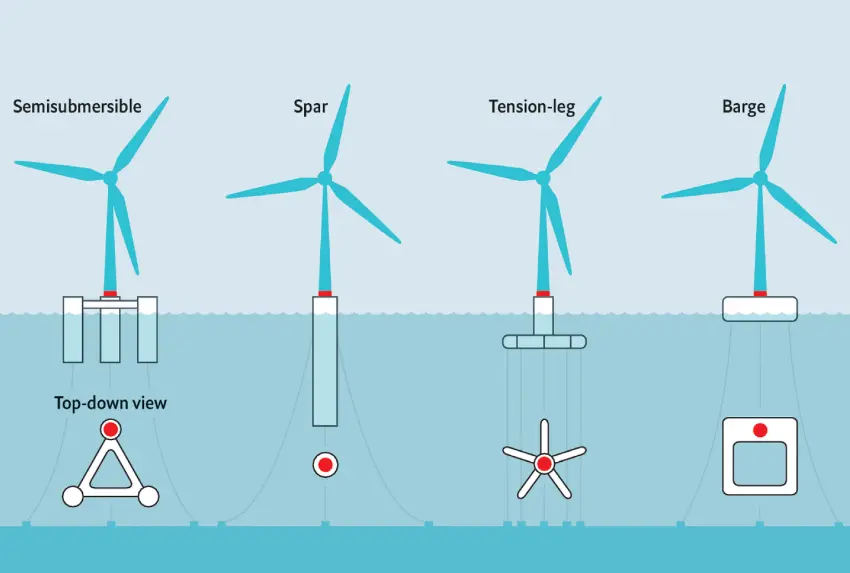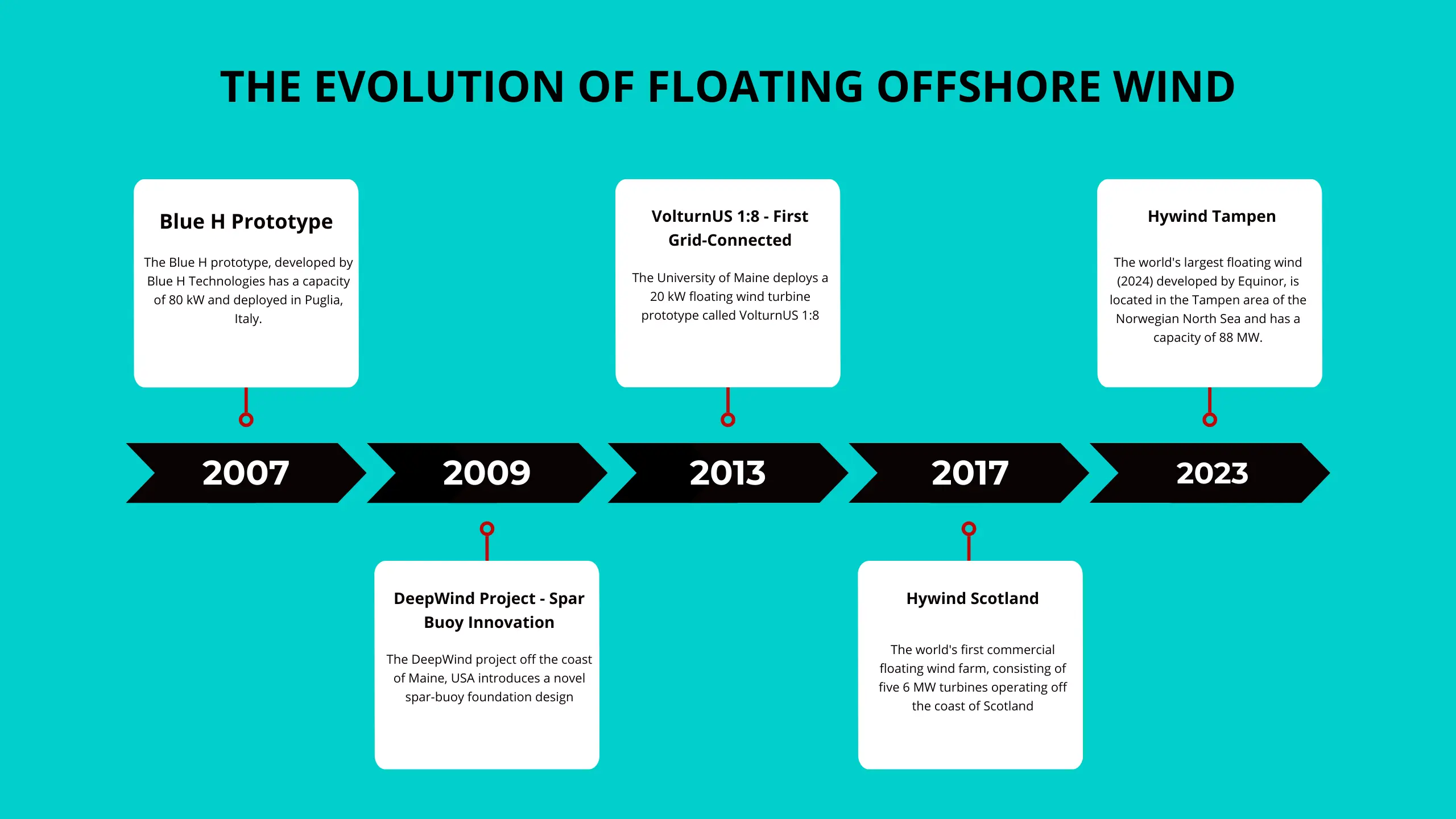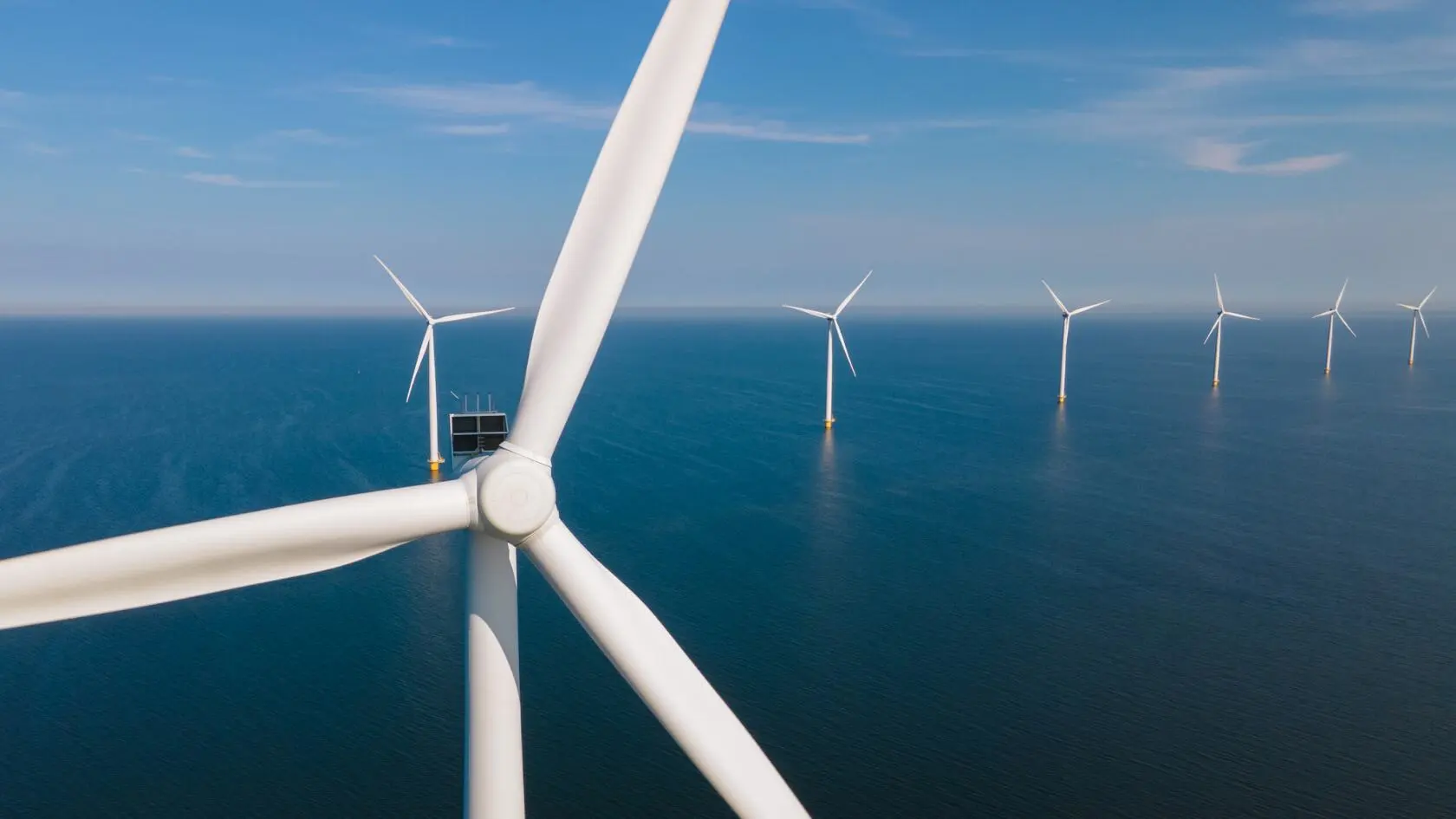Table of Contents
Floating wind farms utilize wind turbines mounted on buoyant platforms instead of fixed structures. These platforms, anchored with mooring lines, bob with the waves while the wind spins the turbine blades, generating electricity. Floating wind farms exist as the Kincardine Wind Farm off the coast of Scotland, which was the world's first commercial floating wind farm, operational since 2017.
Floating offshore wind generates electricity from steady offshore wind, with a turbine attached to a floating structure. Research and developments in offshore wind enabled the generation of electricity from greater water depths, where no fixed structures are possible. These floating platforms are anchored using flexible anchors, chains, or steel cables from the seabed.
The search for clean energy alternatives gained attention in the beginning of this century. Countries are more focused on achieving their targets set for 2030 and 2050. Offshore wind energy has less impact on landscapes and can be expanded to a certain area. Floating wind technology, harnesses wind energy with different floating platforms in deep waters.
What is Floating Offshore Wind Energy?
First, we have to understand what offshore wind energy is: Offshore wind energy can be understood in simple terms, the electricity needed for thousands of households and commercial activities is produced using the kinetic energy of the offshore wind. It is a major source of renewable energy, where the potential of offshore wind is utilised. There are certain developments in the offshore wind farm, from the first offshore wind farm Vindeby to the largest wind farm in the world, Dogger Bank.
Floating offshore wind can be understood as an updated version of offshore wind energy. The industry made one step forward with the technology, the offshore wind farms are deployed in larger and deeper offshore areas with higher wind potential. The floating structures and mooring systems are allocated according to the water depth and weather conditions of the deployment area.
In 2024, a total of 232 MW capacity of floating wind energy will be operated globally. And 2.3GW of floating wind energy is expected to commence by 2030.
Find Floating Offshore Wind Project and Tender Leads around WorldGet Started Now!
How does Floating Offshore Wind Work?
Floating offshore wind is an engineering marvel, where tons of weighed wind turbines are balanced to float even in harsh weather conditions. The wind turbines are much larger than onshore ones, which helps them reach maximum capacity for producing wind energy. The platform will remain floating with the help of the buoyancy force and upward thrust to reduce the weight of the wind turbine.
A floating offshore wind platform (FOWP) helps keep the large offshore wind turbine stable and floating. These floating platforms are made up of steel, concrete, or hybrid structures designed to balance the turbines. The length of wind turbines is subject to change according to the capacity of the wind farm and the speed of the wind.
The basic working principle of floating offshore wind is converting the kinetic energy to electric energy with energy efficiency. The blades rotate to make the shaft in the nacelle turn and a generator in the nacelle produces electricity using the principle of electromagnetism. The produced electricity is transported by underwater cables to an offshore substation and from there to an onshore substation.
The floating wind turbines are designed to produce maximum energy while remaining stable with the help of floating offshore platforms and mooring systems. By minimising the movements, the stability of the turbines is kept to work in optimum conditions. The different types of floating platforms and mooring systems enable the smooth functioning of the floating offshore wind.
Types of Floating Platform Designs

Image Source: encyclopedia.pub
Floating designs are the real test of the floating offshore winds. It helps the offshore wind turbines to float, having an astonishing length of the Eiffel Tower and blades with length of a football field. There are mainly four floating designs used by the major operators with large floating platforms and mooring systems. They are Tension-leg platforms, Semi-submersible, Barge, and Spar buoys.
Tension-leg platform
Tensioned Leg Platforms or TLP are pontoon-based structures anchored with a tensioned mooring system. This floating design aims to reduce the dimensions as much as possible to lower manufacturing costs. The star-shaped structure has three, four, or five arms that help to minimise the volume of each arm and helps the platform to float even without the load. The structure is lighter compared to other designs, which helps to be towed to the offshore anchorage site. Once it reaches the site, tension steel cables or tendons are connected and temporary floats are removed.
Semi-submersible
This floating design uses a column and pontoon-based structure, which minimises the surface area exposed to the water. The structure is anchored to the seabed with a spread mooring system and the maximised volume helps to displace water that provides buoyancy. Several vertical cylinders or parallelepipeds are used to manufacture semi-submersible structures for ideal buoyancy. The beams and braces are joined to create a surface for the floating turbine. This design is versatile to fit different conditions and relatively easy to install. The structure is built complex and less stable than other designs.
Barge
A barge is a large hull-like structure in contact with the water having a large surface area. The length and breadth are significantly larger than the height, which shares the similarities of the ships in terms of dimensions. The large surface area gives more stability to this design, which moves to avoid stresses on the structure. The platform is fitted with plates below the waterline to minimise the movements. The barge is versatile but comparatively less stable than other designs and it uses a spread mooring system.
Spar
A spar is a vertical cylindrical structure with ballast at the bottom for stability. Most of the weight is placed at the lowest possible point to provide stability in this design. Very long cylinders are required to provide stability as the turbines of the floating wind farms become larger. This makes this design more complicated to manufacture, transport, and install in deep oceans. The structure is anchored to the seabed with a spread mooring system and provides good stability.
Evolution of Floating Offshore Wind Technology

The floating offshore wind has a history stretching 50 years back. Floating offshore wind was first introduced in 1972 by Professor William E. Heronemus at the University of Massachusetts Amherst. He was the first to realise the potential of floating wind farms. The prototype of a floating offshore wind turbine was deployed by Blue H Technologies in 2007 near Apulia, Italy, for testing sea and wind conditions. The prototype was decommissioned in 2008.
In 2009, Siemens Wind Power installed the Hywind (or Hywind Demo) large-capacity floating wind turbine in the North Sea near Norway. The turbine, owned by StatoilHydro but sold in 2019, was 213 feet tall and weighed 5,300 tons. Other prototypes were installed worldwide, including in Portugal, the Americas, Japan, China, and the Canary Islands.
The first floating offshore wind farm, Hywind Scotland, was put into operation in 2017 by Equinor. It has achieved the highest average capacity factor of all UK offshore wind farms and has managed to see 60-70% in cost savings compared to the Hywind Demo. The park covers 4 square kilometres and has a capacity of 30 MW. Today, it powers between 20,000 and 34,000 homes in the United Kingdom and has a capacity factor of 54%, higher than previous expectations of 51%.
The largest floating wind farm is Hywind Tampen, located 86 miles off the Norwegian coast. Producing its first energy in November 2022, the farm features a joint mooring system and is expected to have 11 wind turbines featured by 2023 with a capacity of 88 MW.
Future of Floating Offshore Wind

If we consider the onshore as the first generation, floating offshore wind technology is the third generation of harnessing wind energy. In the United States, the Biden administration is putting further investments in offshore wind projects, unveiling its Floating Offshore Wind Shot in September. This will reduce the cost of floating technologies by more than 70% by 2035, to $45 per megawatt-hour, and increase capacity to 15 GW by 2035, enough to power 5 million homes.
The countries bordering the Baltic Sea and the West Coast hold immense potential for floating. By 2050, the World Economic Forum predicts floating wind farms will generate 264 GW or 15% of all offshore wind energy. The average water depth for offshore wind increased by more than six times between 2000 and 2022, according to BloombergNEF, and the average trendline forecast suggests that the upward trend will continue until the water depth reaches approximately 44 metres by 2035.
With a total projected potential of 4,000GW floating wind capacity, 80% of Europe's offshore wind resource potential is in waters deeper than 60 metres. The potential for floating wind capacity in the US and Japan is 60% and 80%, respectively, with 2,450GW and 500GW of potential. These predictions point to the growth of floating offshore wind projects. Also, it underlines that the future of wind energy depends on floating offshore wind farms.
Conclusion
Floating offshore wind technology is always the promising substitute for fossil fuels. This technology involves a floating platform anchored using flexible anchors, chains, or steel cables from the seabed, with various designs such as tension-leg platforms, semi-submersibles, barges, and spars. The future of floating offshore wind projects looks bright, with ocean energy management and projections indicating substantial growth potential and significant contributions to global renewable energy targets by 2050. The industry is expected to see further investments and advancements, aiming to reduce costs and increase capacity to power millions of homes worldwide.
Frequently Asked Questions (FAQs)
What are the issues with floating offshore wind?
The challenges for floating offshore wind include the economics of scaling up the technology, design and structural challenges, manufacture, difficulty in installation, and operational challenges.
What is a floating offshore wind Shot?
The Floating Offshore Wind Shot is a U.S. government push to slash the cost of deep-water wind farms by over 70% by 2035. This ambitious goal targets a price of $45 per megawatt-hour, aiming to unlock the vast clean energy potential of floating offshore wind.
What is the difference between offshore wind and floating offshore wind?
Offshore wind turbines rely on fixed foundations drilled into the seabed, restricting them to shallower waters, typically up to 50 metres deep. In contrast, floating offshore wind turbines utilise moored platforms, allowing them to harness wind energy in much deeper waters, exceeding 60 metres, and even in areas with challenging seabed conditions.
Why is offshore wind stronger?
Offshore winds are consistently stronger than onshore. Because the open ocean offers less friction – no buildings or mountains to slow them down. Additionally, wind can travel long distances over water, gaining strength, unlike over land where obstacles disrupt airflow.
Does the UK have floating offshore wind?
Currently, there are two floating offshore winds in the UK, According to House of Commons UK. One is Hywind Scotland (2017) with five 6 MW turbines 29 km off the coast of Peterhead, developed by Equinor and Masdar. Second, Kincardine wind farm (2021) with five 9.5 MW turbines 15 km off the coast of Aberdeen, was developed by Pilot Offshore Renewables.
Top Floating offshore wind companies?
Major wind turbine manufacturers like Siemens Gamesa and Vestas are actively developing floating wind turbine technology. Equinor operates the world's first commercial floating wind farm, while BW Ideol and Doosan Enerbility bring their expertise in design.
What is Environmental Impact Research in Floating Offshore Wind?
Environmental Impact Research includes effects on marine life, habitat disruption, and underwater noise pollution during construction. The National Renewable Energy Laboratory (NREL) and Pacific Northwest National Laboratory (PNNL) are at the forefront of environmental impact research for floating offshore wind.
Find the Latest Floating Offshore Wind Power Plant Projects in the World with Ease
Are you looking for a platform that gives you reliable, high-quality, and timely project insights for Floating Offshore Wind Farm Projects around the globe?
Discover the Global Project Tracking (GPT) platform by Blackridge Research, designed to provide you with the most recent Global Floating Offshore Wind Power Projects and Tenders better and faster across various stages of development:
- Upcoming projects
- Tender Notices
- Contract award announcements
- Projects in progress or under construction
- Successfully completed projects.
The user-friendly interface helps you obtain early-stage awareness of projects and find the right business opportunity quickly.
Each project will have all the essential details, such as scope, capacity, CapEx, status, project description, companies involved, funding information, location, periodic updates, important event dates like construction start date, commissioning dates, and key contact information of project owners and stakeholders.
The database is a vital resource for a wide range of entities, including developers, EPC companies, project owners, wind turbine suppliers, Operation and Maintenance (O&M) companies, data analytics and software providers, consulting and advisory firms, power utilities, investors and financial institutions lending to projects as well as refinancing existing projects, research and development organisations, companies looking for acquisition of wind power plants, government and regulatory bodies, and law firms.
Book a Free demo to learn more about the Global floating offshore wind farm projects database and how we can help you achieve your goals.

Leave a Comment
We love hearing from our readers and value your feedback. If you have any questions or comments about our content, feel free to leave a comment below.
We read every comment and do our best to respond to them all.